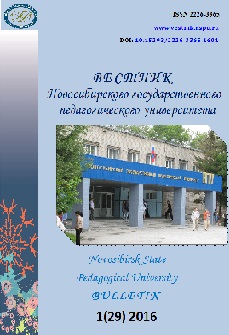Особенности психофизиологической адаптации учащихся в различных условиях обучения
Features of psychophysiological adaptation of pupils in different learning environments
Author(s): Olga Leonidovna Tarasova, Olga Nikolaevna Chetveric, Alexander Ivanovich Fedorov, Pavel Yurievich Zarchenko, Eduard Mihailovich KazinSubject(s): School education, Individual Psychology, Experimental Pschology
Published by: Новосибирский государственный педагогический университет
Keywords: Adolescence (human); physiological adaptation; psycho-physiological adaptation to training; vegetative stage; the type of vegetative regulation; neurodynamic features
Summary/Abstract: Question studying age-related features of psychophysiological development and school-boys adaptation to educational activity in a variety of the conditions for instruction is of particu-lar relevance in adolescence age of individual development. A comparative analysis of vegeta-tive and neurodynamic indicators younger and older adolescents from educational organiza-tions with varying training intensity (229 persons). The features that reflect the specifics of ado-lescent adaptation to training and factors of educational environment. These results reflect the peculiarities of psychophysiological adaptation of adolescents enrolled in comprehensive school and grammar school. Learners general educational schools are characterized by a more pronounced voltage of adaptation mechanisms, and lower levels of neurodynamic indicators in comparison with by pupils the grammar school, that is especially pronounced at the initial stage of training at the basic school. On indicators of psychophysiological adaptation have an impact typological features of vegetative regulation. For teenagers with the balanced autonomic tone are characteristic of higher rates of psychomotor reactions. Interrelation of vegetative and neu-rodynamic features of is most pronounced at a voltage of adaptation mechanisms and the low level of neurodynamic characteristics. The results can be used to optimize the individually-differentiated approach in educational process taking into account the learning conditions in the educational organization.
Journal: Вестник Новосибирского государственного педагогического университета
- Issue Year: 6/2016
- Issue No: 1
- Page Range: 23-37
- Page Count: 16
- Language: Russian

